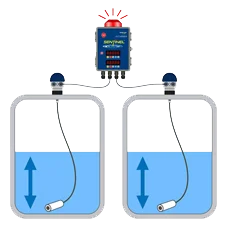Compliance Advisory Tank Level Alarms

A tank level alarm is a device that is used to monitor the liquid level in a tank and to alert operators or other personnel when the level reaches a certain point. The specific way that a tank level alarm works will depend on the type of alarm and the type of liquid being monitored, but in general, they operate by using one or more sensors to measure the level of the liquid in the tank and then sending a signal to an alarm or control system when the level reaches a preset point.
The following are some common types of sensors and technologies used in tank level alarms, and how they work:
- Submersible Level sensors with a local display that has relay outputs is an excellent choice for monitoring your chemicals and providing a high level alarm to reduce any overspill conditions
- Float sensors: A float sensor is a device that uses a buoyant object that floats on top of the liquid and is connected to a sensor that sends a signal when the float reaches a certain point. The sensor can be mechanical or electronic. As the liquid level in the tank rises, the float will also rise. When the float reaches the preset point, the sensor sends a signal to the alarm or control system.
- Ultrasonic sensors: An ultrasonic sensor uses sound waves to measure the distance between the sensor and the surface of the liquid. The sensor sends out a sound wave and measures the time it takes for the wave to bounce back. The sensor then calculates the level of the liquid based on the distance to the surface.
- Conductivity sensors: A conductivity sensor uses electrical conductivity to measure the level of the liquid. The sensor sends an electrical current through the liquid and measures the resistance to determine the level of the liquid. This method is relatively accurate and can be used with a wide range of liquids.
- Radar sensors: A radar sensor uses radar waves to measure the distance between the sensor and the surface of the liquid. The sensor then calculates the level of the liquid based on this distance. This method is relatively accurate and can be used with a wide range of liquids.
Once the sensor sends a signal indicating that the liquid level has reached a certain point, the alarm or control system will take appropriate action. This can include sounding an alarm, shutting off the flow of liquid into the tank, or activating other safety systems such as emergency shutdown valves.
It’s important to note that tank level alarms should be regularly inspected and maintained to ensure that they are working correctly and to prevent any malfunctions. Training of personnel on the proper use and maintenance of the alarm system is also crucial.
In summary, a tank level alarm is a device that is used to monitor the liquid level in a tank and to alert operators or other personnel when the level reaches a certain point. Tank level alarms use one or more sensors to measure the level of the liquid in the tank, these sensors can be float, ultrasonic, conductivity or radar sensors. Once the sensor sends a signal indicating that the liquid level has reached a certain point, the alarm or control system will take appropriate action. Regular inspection and maintenance of the alarm system, as well as training of personnel, is crucial to ensure proper function and prevent any malfunctions.
Learn more about tank level sensors
Learn more about tank level alarms
Please contact us to discuss your application


